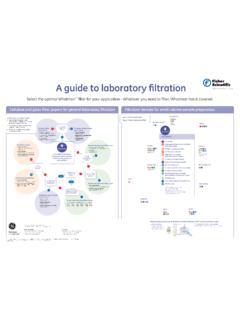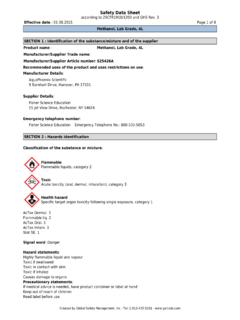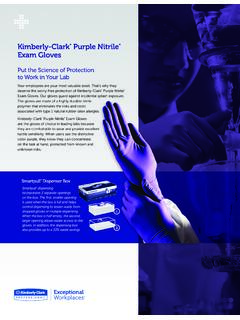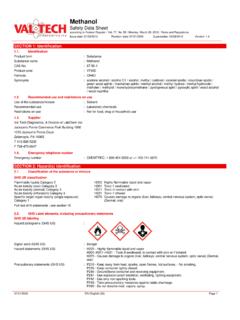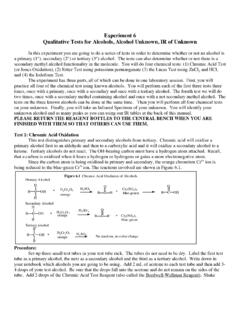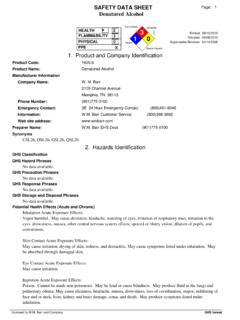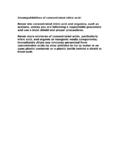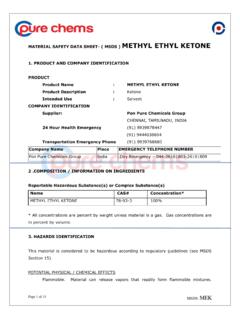Transcription of NMR Proton Shifts for Residual Solvent Impurities
1 SolventSynonymsMol Wt BP C Linear Formula H-Signal Multi CDCl3 D2O CD3OD (CD3)2SO(CD3)2 COCD3 CNC6D6 Acetic AcidEthanoic AcidMethanoic 1-Butanoln-Butanol / 1-Hydroxybutane / n-Butyl (CH2) CH2 (3) CH2 (2) CH2 (1) 2-Butanolsec-Butanol / 2-Butyl alcohol / 2-Hydroxybutane (OH)CH2CH3CH3 (4) CH3 (1) tert-Butanolt-Butyl alcohol / 2- methyl -2-propanol (CH3) GlycolEthane-1,2-diol / 1,2-Dihydroxyethane / Hexyl alcohol / Caproic alcohol (CH2) CH2 (3-5) CH2 (2) CH2 (1) iso-Amyl alcohol3- methyl -1-butanol / iso-Pentyl alcohol (CH3) iso-Butanoliso-Butyl alcohol / (CH3) MethanolMethyl alcohol / Pentyl alcohol (CH2) CH2 (3-4) CH2 (2) CH2 (1) 1-Propanoln-Propanol / Propyl alcohol CH2 (2) CH2 (1) 2-PropanolIPA / Isopropanol / iso-Propyl alcohol (CH3) / methyl phenyl ether CH (o/p) CH (m) (2) (3) (4) (o/p) (m) 1,4-Dimethylbenzene / p-Xylol (CH3) ChloroformTrichloromethane / Formyl ,2-DichloroethaneEDC / Ethylene dichloride / Glycol dichloride / Methylene dichloride / methyl cyanide / Cyanomethane / (CH3) sulfoxideDMSO / methyl sulfoxide / (Methylsulfinyl) (CH3) acetate1-Butyl (CH2)
2 Ethyl acetateEtOAc / Ethyl ethanoate / Acetoxyethane formateEthyl methanoate / Formic acid ethyl ester iso-Propyl acetateiPrOAc / 1- methyl ethyl acetate / 2-Propyl acetate (CH3)2(CH3) methyl acetateMethyl ethanoate / methyl acetic ester n-Propyl acetateAcetic acid propyl ester / Propyl ethanoate tert-Butyl methyl etherMTBE / 2- methyl -2-methoxy propane (CH3) etherEther / Ethoxyethane (CH3CH2) ,2-DimethoxyethaneDME / ,4-DioxaneDiethylene ether / Diethylene / Oxolane / Diethylene / Dipropyl methane (CH2) n-Hexane (CH2) (CH2)5CH2CH (ax) CH2 (4) (ax) CH2 (3) (ax) (CH2) / Dimethylketone / methyl butyl ketone / Propyl acetone (CH2) Isobutyl methyl ketoneMIBK / 4-Methylpentan-2-one / Isopropylacetone (CH3)2 CHCH2 COCH3(CH3) methyl ethyl ketoneMEK / Ethyl methyl ketone / / (C2H5) / Formic GreaseLong chain, linear aliphatic hydrocarbons GreasePoly(dimethylsiloxane) Visit Proton Shifts for Residual Solvent ImpuritiesOHORA cidicOHRCIRRC+-RRORRR1 OROORR1H3C(CH2)nRAlcoholAromaticEsterChl orinatedDipolar AproticEtherKetoneHydrocarbonMiscellaneo usReferences - Green Chem.
3 , 2016, 18, 3867-3878. Magn. Reson. Chem., 2005, 43, 497-509. J. Org. Chem., 1997, 62(1), 7512 -7515. Solvent TypeVisit Harmonized System of Classification and Labelling of Chemicals (GHS)ExplosiveCompressed Gas Harmful or IrritantGHS01 GHS04 GHS07 Self-reactives (severe) Organic peroxides Gas under pressure Irritation (skin or eyes) Skin sensitizer Acute toxicity (harmful) Specific target organ toxicity single exposure (drowsiness or dizziness or respiratory irritation) Hazardous to the ozone layerFlammable CorrosiveHealth HazardGHS02 GHS05 GHS08 Pyrophorics Self-reactives Self-heating In contact with water liberates flammable gases Organic peroxides Skin corrosives/burns Eye damage Corrosives to metals Carcinogen Respiratory sensitizer Reproductive toxicity Specific target organ toxicity single or repeated exposure Germ cell mutagenicity Aspiration toxicity OxidizingToxicHazardous to the EnvironmentGHS03 GHS06 GHS09 Acute toxicity (fatal or toxic) Hazardous to the aquatic environment (acute or long term) May cause fire or explosion Strong oxidizer May intensify fireBN040317CH21




